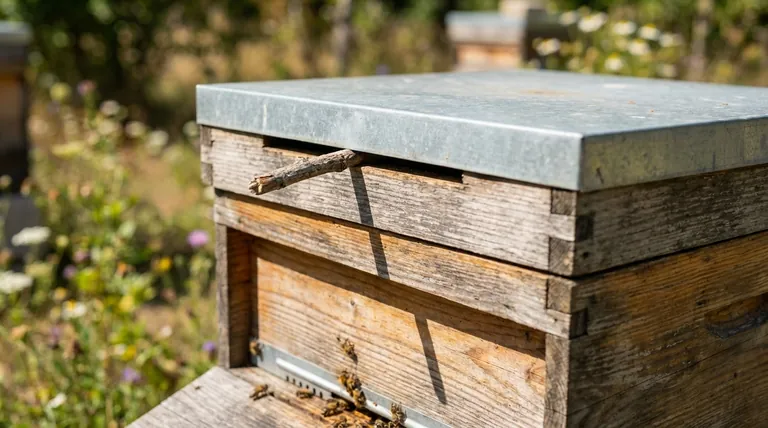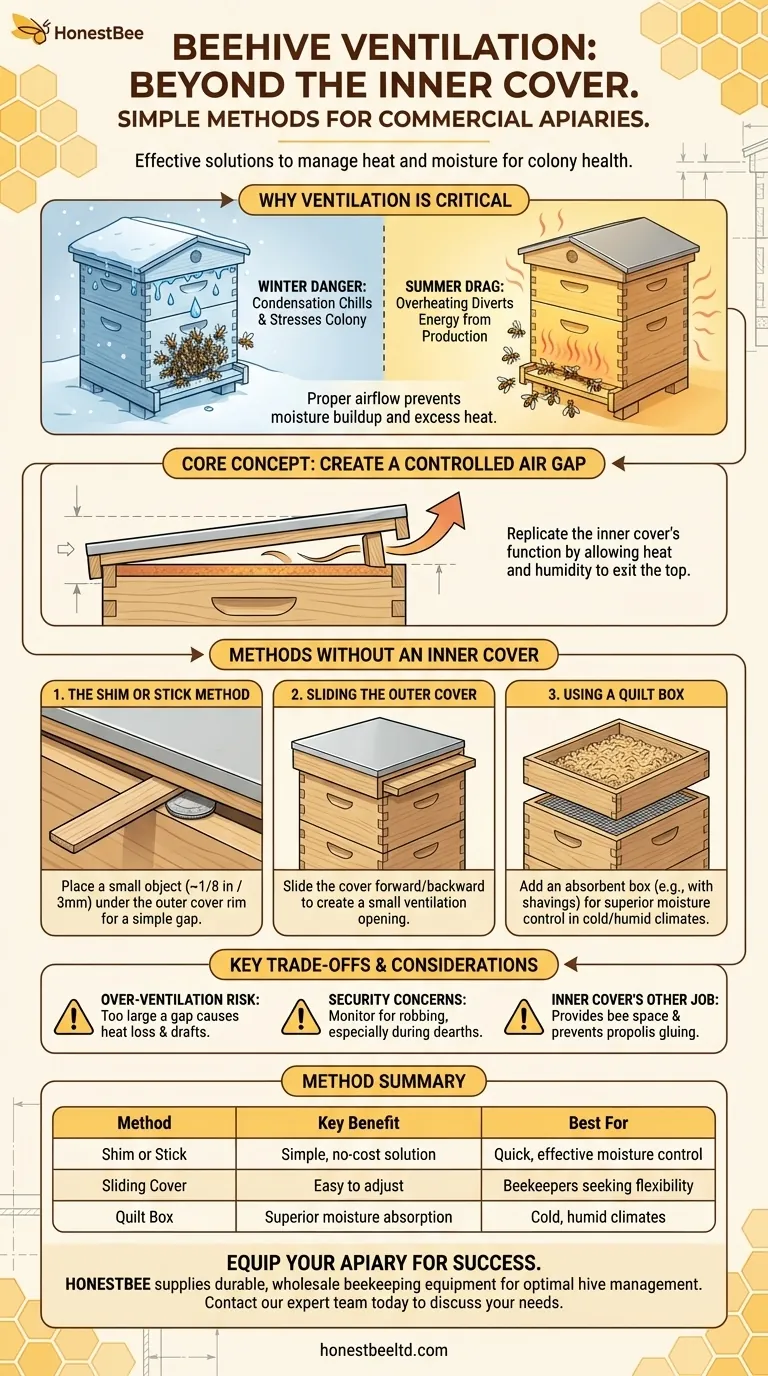To add ventilation to a beehive without an inner cover, you can place a small stick, coin, or wood shim under one edge of the telescoping outer cover. This simple action creates a small gap at the top of the hive. This upper entrance allows warm, moisture-laden air generated by the bee cluster to escape, preventing condensation and promoting a healthier internal environment.
While an inner cover is a tool designed for ventilation, its core function is simply to create a controlled air gap at the top of the hive. You can easily replicate this critical function by propping open the outer cover, ensuring that heat and moisture have a way to exit.

Why Top Ventilation is Critical for Hive Health
A beehive is a living system that generates significant heat and humidity. Properly managing this internal atmosphere is one of the most important jobs of a beekeeper, directly impacting the colony's survival and productivity.
The Problem: Trapped Moisture
Bees release water vapor as they metabolize honey. In a sealed hive, this warm, moist air rises. When it hits the cold inner surface of the hive cover, it condenses into water droplets.
The Winter Danger: Condensation
In winter, this condensation is the primary threat to a colony. Cold water dripping down onto the winter cluster can chill the bees, causing stress and death. A wet colony is a cold colony, and a cold colony will struggle to survive until spring.
The Summer Drag: Overheating
In summer, a lack of ventilation can lead to overheating. This forces the bees to work harder to cool the hive by fanning their wings and "bearding" on the outside. This diverts energy away from essential tasks like foraging, caring for brood, and producing honey.
Methods for Top Ventilation (Without an Inner Cover)
Achieving top ventilation is about creating a small exit path for air. The inner cover is just one way to do this; several other methods are just as effective.
The Shim or Stick Method
This is the most direct and simple approach. By placing a small object under the rim of your outer cover, you create a ventilation gap.
A small twig, a coin, or a purpose-made wooden shim of about 1/8 inch (3mm) is sufficient. This small opening is all that's needed for effective air exchange.
Sliding the Outer Cover
Some beekeepers simply slide the entire telescoping outer cover forward or backward by a small amount. This can also create a ventilation gap at the front or back of the hive.
This method achieves the same goal as using a shim, creating that crucial upper exit for air.
Using a Quilt Box
For beekeepers in very humid or cold climates, a quilt box is an excellent alternative. This is a shallow box with a screened bottom that is placed on top of the uppermost hive box.
The box is filled with insulating material like wood shavings, which absorbs moisture from the hive while still allowing air to pass through. It provides superior insulation and moisture control.
Understanding the Trade-offs
While top ventilation is essential, it's important to understand the potential downsides of creating an upper entrance.
The Risk of Over-Ventilation
Creating too large a gap can result in excessive heat loss. In winter, this forces the bees to consume more honey to stay warm.
The goal is a small crack for moisture to escape, not a large opening that creates a draft. A 1/8-inch gap is a reliable starting point.
Security and Robbing Concerns
Any entrance can be a potential access point for robber bees from other colonies or pests like wasps. This is primarily a concern during a nectar dearth (typically late summer).
A small ventilation gap poses a minimal security risk, as the colony can easily defend it. However, you should always monitor for signs of robbing.
The Inner Cover's Other Job
It is important to acknowledge that the inner cover also serves to create bee space between the top bars and the outer cover. This prevents the bees from gluing the outer cover down with propolis, making hive inspections much easier. Working without one may mean you need to use your hive tool more forcefully to open the hive.
Making the Right Choice for Your Goal
Your approach to ventilation should align with your climate, equipment, and management style.
- If your primary focus is a simple, no-cost solution: Use a small stick or shim to prop open the outer cover by about 1/8 inch (3mm).
- If your primary focus is managing high humidity in a cold winter: Consider building or buying a quilt box to place above your top hive body for superior moisture absorption.
- If your primary focus is balancing ventilation with hive security: Ensure the gap you create is minimal and monitor the hive for any signs of robbing, especially during late summer.
Effective beekeeping is about understanding principles, not just owning specific equipment, and creating top ventilation is a perfect example of this practical approach.
Summary Table:
| Ventilation Method | Key Benefit | Best For |
|---|---|---|
| Shim or Stick | Simple, no-cost solution | Quick, effective moisture control |
| Sliding Outer Cover | Easy to adjust | Beekeepers seeking flexibility |
| Quilt Box | Superior moisture absorption & insulation | Cold, humid climates |
Ensure your apiary thrives with the right equipment. Proper hive ventilation is critical for colony health and honey production. At HONESTBEE, we supply commercial apiaries and beekeeping equipment distributors with durable, wholesale-focused beekeeping supplies designed for optimal hive management. Let us help you equip your operation for success. Contact our expert team today to discuss your wholesale needs.
Visual Guide

Related Products
- Black Plastic Beetle Barn Hive Beetle Trap for Beehives
- Stainless Steel Bee Hive Frame Wire for Beekeeping
- Reusable Clear Small Hive Beetle Traps for Beehives Beetle Trapping Tools
- Professional Bamboo Queen Isolation Cage
- Australian Pine Wood Langstroth Screen Bottom Board for Wholesale
People Also Ask
- What is the best time to use beetle traps? Master the Spring Strategy for Effective Hive Protection
- How should beetle traps be placed in the hive? Achieve Perfect Flush Placement for Maximum Control
- How do hive beetle traps work? A Beekeeper's Guide to Non-Chemical Control
- What are the steps for installing hive beetle traps? A Guide to Effective Beetle Control
- Why are hive beetle traps important for beekeepers? Protect Your Hive from a Devastating Infestation



















